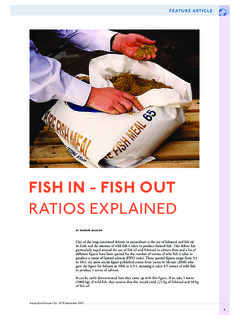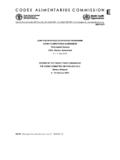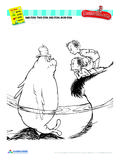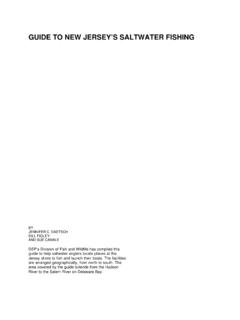Transcription of Demand perspectives on fishmeal & fish oil - IFFO
1 Demand perspectives on fishmeal & fish oil Jonathan Shepherd International fishmeal & fish Oil Organisation North Atlantic Seafood Forum Oslo 3 March 2011. IFFO. International fishmeal and fish Oil Organisation is the global trade association representing fishmeal and fish oil producers and related trades. Represents two thirds of world production and 80% of trade in fishmeal and fish oil worldwide with producers in Europe, South America, Africa, USA, China and India. Important feed ingredients fishmeal is an excellent high protein feed ingredient used at least at some stage in almost all intensive aquaculture systems fish oil is the best source of the omega-3 fatty acids EPA & DHA.
2 And its use in feeds ensures a healthy product for the final consumer However, despite the growth of aquaculture the global production of both fishmeal & fish oil has remained fairly static Global fishmeal & fish Oil Production 1963-2009. thousand tonnes 8000. 7000. tonnes ,000. 6000. 5000. 4000 fishmeal 3000. 2000 fish Oil 1000. 0. IFFO data Production of fishmeal and oil has remained relatively steady although the introduction of precautionary quotas &. increased use for direct human consumption has resulted in reduced volumes of whole fish going for fishmeal & oil Consumption of fishmeal is increasingly being concentrated in Asia with China continuing as by far the single largest market.
3 In fish oil Europe continues to dominate the market with Latin America using less with the reduction in salmon production in Chile Eco-efficiency of fishmeal & fish oil Seasonal surplus of less desirable fish and inedible by-products are collected. They are efficiently converted into concentrated stable products which can be economically shipped to where they are required IFFO estimates 2008. Volumes of whole fish being used as feed are decreasing Whole fish rendered for different purposes Tonnes ,000. 25,000. 20,000. Aquaculture 15,000 Oil for Human Consumption Oil other uses Other land animals 10,000.
4 Pigs Chickens 5,000. 0. 2000 2001 2002 2003 2004 2005 2006 2007 2008. Will static supplies of marine ingredients limit aquaculture growth? As prices rise alternatives ( soy meal, rapeseed oil) are used in partial replacement Increasing nutritional knowledge allows more replacement to take place particularly on more established species Improved genetics and processing are improving the quality of alternative proteins Increasingly fishmeal is being used as a strategic ingredient at lower levels and retained in special diets fry and broodstock diets Global aquaculture production has continued to grow while usage of fishmeal & fish oil is static 60 50.
5 40. Tonnes millions Aquaculture 30 Fed Aquaculture fish meal used in 20 aquaculture fish Oil used in aquaculture 10. 0 Data FAO & IFFO. 2000 2001 2002 2003 2004 2005 2006 2007 2008. fishmeal usage moves from Agri' to Aqua' sector Two species (chicken & pigs) used over 98% of production in 1960 but dropped to 40% of usage while production grew from 32 to 182 million tonnes We estimate that in 2009 63% of global fishmeal production went to aquaculture and IFFO data that was split almost equally between salmonids, marine fish , crustacean and others. The transition of fishmeal from commodity to strategic ingredient has been accompanied by an upwards trend in relative value Why are fishmeal prices again at a historical high?
6 All feed commodities have risen strongly current ratio with soymeal is still around 4:1. Continuing strong Demand for fishmeal from SE Asia - particularly China Last year's El Ni o in Peru resulted in a large number of immature fish which has caused the early closure of the fishery but the fish will mature and breed Issue with uncontrollable fishing in international waters has given problems to the Chilean Jack mackerel fishery fish oil usage moves from hydrogenated fat to aquaculture & capsules mm A growing recognition of the importance of EPA & DHA. We estimate that in 2009. 81% of global fish oil production went to aquaculture and that 68%.
7 Of that went to salmonids. Direct Human Consumption, ** Other usage including fat hydrogenation & industrial use Source IFFO. The easy replacement of fish oil by rapeseed oil in salmon diets has meant the price ratio of feed grade oil has slightly trended down although current ratio is around :1. However, the growth of fish oil for direct human consumption is opening up a significant market (currently 20-25%) with a price premium GOED 2009 estimates The result of the growing replacement of fish oil in salmon diets: The nutrient requirements of the salmon can be met by low dietary levels of fish oil (5%).
8 However, this might have a negative effect on their performance and survival under stressful conditions, especially given high omega-6. The final level of EPA/DHA in the fillets is decreasing Salmon have been sold on their health giving properties and this will be increasingly challenged Feeding fish to fish is the most efficient feed use fish being cold blooded animals and supported by water are the most efficient users of feed Typical Feed Conversion Ratios: Pigs 4:1, Poultry 2:1, fish :1. Typical Protein Retention levels: Pigs 13%, Poultry 18%, fish 40%. Feeding fish to fish fish is a natural food for fish all fish are carnivorous at some stage fishmeal & fish oil provide an almost perfect nutrient balance promoting health & welfare Ethical objections about not feeding the poor are misplaced Increasing amounts are going for direct human consumption Some are concerned about the ethics of feeding fish to fish subject of a recent FAO report The idea of landing large quantities of anchoveta, or sand eel, or most of the other species used in feed fisheries, and using them to provide food for the poor is a laudable objective, but unrealistic.
9 There does not seem to be any foundation for the argument that aquaculture threatens the sustainability of South American reduction fisheries and, therefore, endangers the food security of those who are already undernourished or the income levels of the poor in Chile, Peru or anywhere else . But he says : Where feed fisheries are not managed sustainably, aquaculture today constitutes an important threat to world fish stocks because of aquaculture's reliance on fishmeal and thus on reduction fisheries . o Most fisheries have been poorly managed at some stage o Significant improvements have been made in the last ten years o For example Peru now has some of the best managed fisheries in the world: RANKING MARITIME COUNTRIES.
10 BY THE SUSTAINABILITY OF THEIR. FISHERIES Mondoux et al (2008). Responsible management of fisheries World's largest feed fishery - the Peruvian anchovy now well managed Europe re-building their feed fisheries Still concern over feed fisheries in Asia mostly due to the use of trash fish and a lack of fisheries information It is becoming increasingly important to be able to demonstrate responsible fisheries management of the raw material So there is continued value chain concern over two critical areas The need to demonstrate that any whole fish The need to demonstrate that production in processed come from well managed fisheries the factory ensures pure and safe








